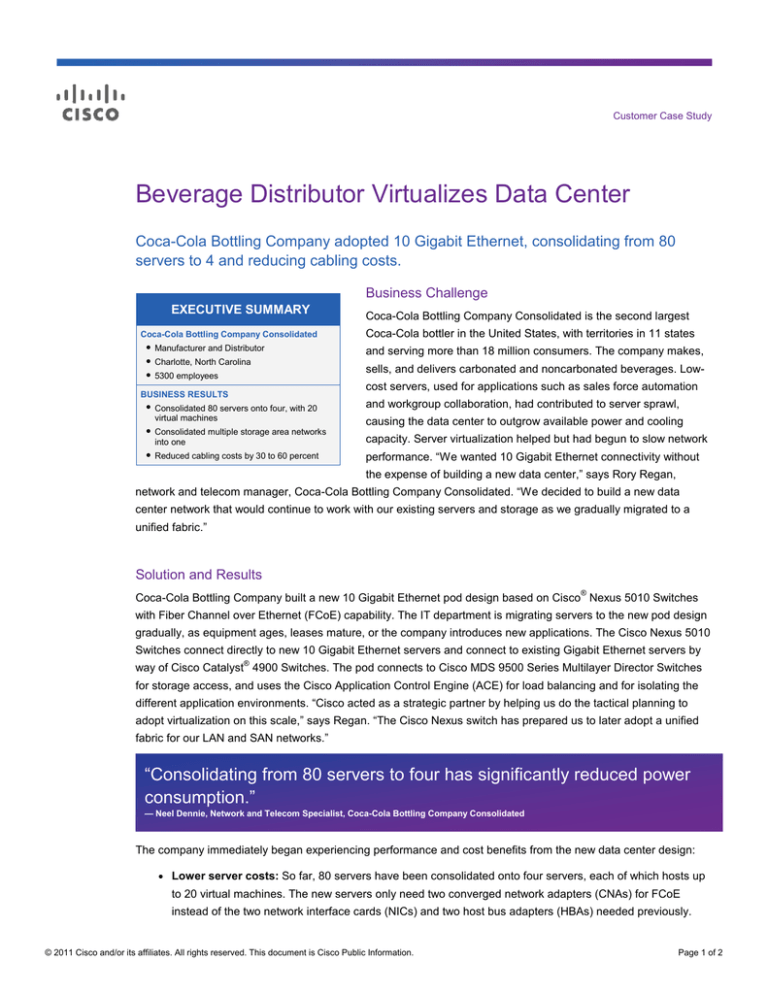
Customer Case Study
Beverage Distributor Virtualizes Data Center
Coca-Cola Bottling Company adopted 10 Gigabit Ethernet, consolidating from 80
servers to 4 and reducing cabling costs.
Business Challenge
EXECUTIVE SUMMARY
Coca-Cola Bottling Company Consolidated
● Manufacturer and Distributor
● Charlotte, North Carolina
● 5300 employees
BUSINESS RESULTS
● Consolidated 80 servers onto four, with 20
virtual machines
● Consolidated multiple storage area networks
into one
● Reduced cabling costs by 30 to 60 percent
Coca-Cola Bottling Company Consolidated is the second largest
Coca-Cola bottler in the United States, with territories in 11 states
and serving more than 18 million consumers. The company makes,
sells, and delivers carbonated and noncarbonated beverages. Lowcost servers, used for applications such as sales force automation
and workgroup collaboration, had contributed to server sprawl,
causing the data center to outgrow available power and cooling
capacity. Server virtualization helped but had begun to slow network
performance. “We wanted 10 Gigabit Ethernet connectivity without
the expense of building a new data center,” says Rory Regan,
network and telecom manager, Coca-Cola Bottling Company Consolidated. “We decided to build a new data
center network that would continue to work with our existing servers and storage as we gradually migrated to a
unified fabric.”
Solution and Results
®
Coca-Cola Bottling Company built a new 10 Gigabit Ethernet pod design based on Cisco Nexus 5010 Switches
with Fiber Channel over Ethernet (FCoE) capability. The IT department is migrating servers to the new pod design
gradually, as equipment ages, leases mature, or the company introduces new applications. The Cisco Nexus 5010
Switches connect directly to new 10 Gigabit Ethernet servers and connect to existing Gigabit Ethernet servers by
®
way of Cisco Catalyst 4900 Switches. The pod connects to Cisco MDS 9500 Series Multilayer Director Switches
for storage access, and uses the Cisco Application Control Engine (ACE) for load balancing and for isolating the
different application environments. “Cisco acted as a strategic partner by helping us do the tactical planning to
adopt virtualization on this scale,” says Regan. “The Cisco Nexus switch has prepared us to later adopt a unified
fabric for our LAN and SAN networks.”
“Consolidating from 80 servers to four has significantly reduced power
consumption.”
— Neel Dennie, Network and Telecom Specialist, Coca-Cola Bottling Company Consolidated
The company immediately began experiencing performance and cost benefits from the new data center design:
●
Lower server costs: So far, 80 servers have been consolidated onto four servers, each of which hosts up
to 20 virtual machines. The new servers only need two converged network adapters (CNAs) for FCoE
instead of the two network interface cards (NICs) and two host bus adapters (HBAs) needed previously.
© 2011 Cisco and/or its affiliates. All rights reserved. This document is Cisco Public Information.
Page 1 of 2
●
Lower SAN costs: The Cisco MDS 9509 Multilayer Director Switches consolidate the company’s
mainframe disk, open systems disk, and tape backups onto the same physical network. The IT department
created a virtual SAN (VSAN) for each type of traffic.
●
Lower cable costs: The new pod design reduces cabling costs by 30 to 60 percent by consolidating from
six Cat5 cables plus two 50 mm fiber cables to two SFP+ cables. Rear-facing server ports on the Cisco
Nexus 5010 Switches simplify cabling.
●
Space and power savings: “Consolidating from 80 servers to four has significantly reduced power
consumption,” says Neel Dennie, network and telecom specialist, Coca-Cola Bottling Company
Consolidated.
●
A “force multiplier” for IT: The company uses dual Cisco MDS 9509 Multilayer Director Switches. “Using
the same operating system for our SAN and data network means that twice as many people now have the
skills to manage our switches, at no extra cost to us,” says Regan. IT personnel are also able to use
existing skills to manage the Cisco ACE 4710 Appliance for load balancing and rapid application
provisioning. “By saving us time, Cisco data center solutions are a force multiplier for our IT department,”
Regan adds.
●
Lower cooling costs: Front-to-back airflow in the Cisco Nexus 5010 lets the IT department control airflow
direction, which reduces cooling costs.
Coca-Cola Bottling Company is preparing to use the Cisco Nexus 1000V Switch, which resides on the server to
deliver VN-Link virtual machine-aware network services. “The Cisco Nexus 1000V simplifies collaboration within
the IT department by clearly separating responsibilities for our server group and network group,” says Regan. “It
also enables vMotion to work properly by giving server specialists the freedom to move hosts around without
concerning themselves with quality of service and security settings.”
“By saving us time, Cisco data center solutions are a force multiplier for
our IT department.”
— Rory Regan, Network and Telecom Manager, Coca-Cola Bottling Company Consolidated
For more information about the Cisco Nexus Switch Family, visit: http://www.cisco.com/go/nexus.
For more information about Cisco MDS 9500 Series Multilayer Director, visit: http://www.cisco.com/go/mds.
Printed in USA
© 2011 Cisco and/or its affiliates. All rights reserved. This document is Cisco Public Information.
C36-555689-01
04/11
Page 2 of 2


